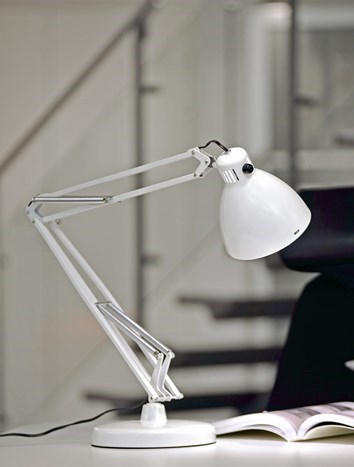Our history of lighting for the individual began with the development of the Luxo L-1 task light in 1937. Luxo L-1 soon became known as a real productivity booster in schools, offices and healthcare facilities, and a design icon among architects and designers all over the world. This was the start of a range of lighting products that are ergonomically correct and individually adaptable, avoiding glare and other health related problems. Today we have a range of energy-efficient task lights that can help create a highly ergonomic workspace. They are known for their aesthetic design, excellent mechanics, high lumen output, quality finish and careful material selection. When selecting the proper workstation lighting, there are several things you should consider. Check out our task lighting guide here.
Nine things you should know about task lighting
- The amount of light you need varies with your age
The older we get, the more the amount of light we need for proper visual comfort increases. Research confirms that a 60-year-old requires 5-6 times as much light as a 20-year-old. - The amount of light you need varies with the job at hand
Reading from a sheet of paper requires a lot more light than if you are working at your computer. And if you are inspecting an object or making a quality assessment, you need more light than if you are writing with a pen on paper. For this reason, it’s important that you should be able to regulate the amount of light at your workstation yourself. All our task lights are dimmable, so it’s easy to adjust the amount of light to suit different age groups and tasks. Some products even feature the Tuneable White functionality. Touch the switch, and the light changes from warm white to cool white in three effortless steps. - Poor lighting causes unwanted aches and pains
A whole range of unwanted aches and pains, headaches, neck and back ailments and eyestrain can be attributed to poor lighting. This is because the body compensates for poor lighting: we adopt unhealthy postures in order to see well. When equipping or refurbishing your workplace, it’s essential to provide adequate light from an adaptable and easily adjusted source. - Individual task lights are the key to good workstation lighting
Personal task lights are one of the most important factors for achieving an optimal workstation environment. An individually adjustable ergonomic desk light provides complete flexibility and affords each employee total control over the lighting at his or her workspace. There can be substantial variations in preferred light settings and research has taught us that individual lighting control can affect job satisfaction positively, as well as increase the wellbeing of users. - Asymmetrical light is optimal for your eyes
The best solution for achieving optimal workspace lighting is an asymmetrical task light. This means that the light is emitted sideways, so that the task light can be placed to the side of your desk and not get in your way. Our task lights has built-in functionality that makes it easy to direct the light exactly where you want it. Requirements for good workspace lighting are laid down in the international standard for indoor workplace lighting, EN 12464-1. Luxo task lights fulfil the illuminance requirements of a minimum average of 500 lux on the desk surface. - Even light is attractive – glare is not
Ergonomically designed task lights distribute light evenly across the working area. The even light distribution eases the transition between light and dark areas on the working surface and allows your eye to work in a constant, comfortable light. Importantly, they prevent reflection and will not cause any glare or discomfort to colleagues at neighbouring desks. - Challenges with height-adjustable desks
Height-adjustable desks are an increasingly common feature in any modern office environment. This is a very attractive solution for individual employees, and a must in open-plan offices where different people use the same workstation. Just remember that when the height of the desk changes, so does your lighting. You may find that your own body is blocking the light. However, a task light on a height-adjustable desk will always be in the right position on the desktop. - Individual task lights allow for reduced general lighting
By placing a task light at each workstation, we are not only providing individual employees with a good and ergonomically correct lighting solution. It also makes it possible to substantially diminish the light intensity of the general lighting in the room. This allows for reduced energy consumption and contributes to a better working environment. - LED lighting solutions are energy-efficient and economical
Our task lights are equipped with the latest LED technology and designed to provide the best possible ergonomics for the work place while saving energy. The Glamox range of task lights offers excellent lumen output values, colour rendering capabilities and bright, warm light. Some of the task lights even have a dim-to-warm functionality, which yields an excellent workstation light or relaxing warm light when dimmed down. LEDs have an incredibly long lifespan. Energy saving is important, and that’s why the task light has a timer or sensor that turns the workstation light on when motion is detected, and turns it off after a period of inactivity. The LEDs in a modern task light have a life expectancy of 50,000 hours. That means 25 years or more with normal office use. You will never have to change the light source!
,(0.5,0.5627962,1,0.8649289)&format=jpg)